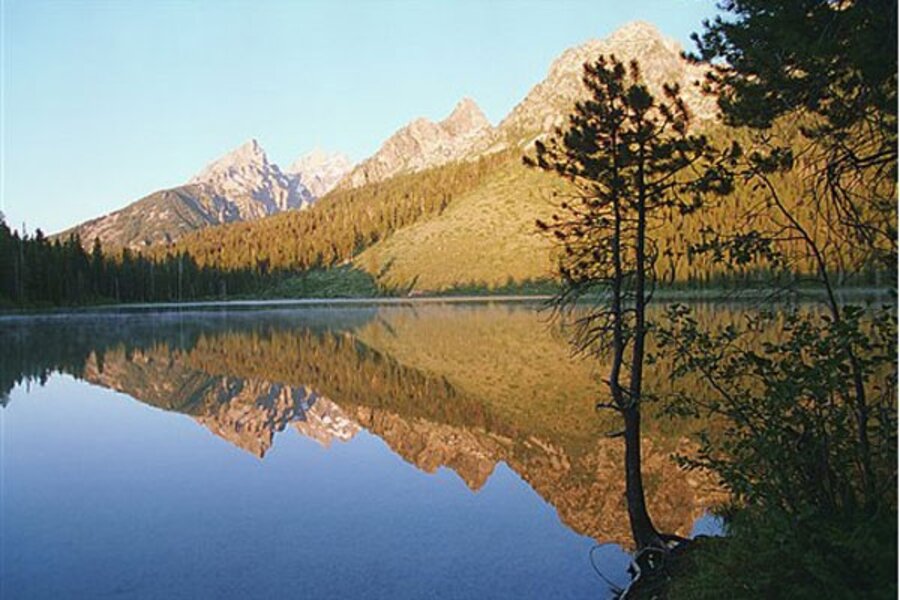Old photos show that Teton glaciers are shrinking
Loading...
| CHEYENNE, Wyo.
Glaciers on the iconic Teton Range are shrinking, researchers say, joining a growing list of glaciers in North America and beyond that are losing their surface area and potentially reducing the water supply for nearby regions.
Two of the Tetons' biggest glaciers have lost more than 20 percent of their surface area since the late 1960s, three University of Wyoming researchers concluded after comparing old and new aerial photographs of the glaciers.
The glaciers are a fairly substantial source of irrigation water, meaning the findings have wider implications than simply what the mountains look like to tourists by late summer. People in Wyoming and Idaho and, to a lesser extent, Utah use water from the glaciers.
"From an engineering-water supply perspective, we look at them as frozen reservoirs," said Glenn Tootle, a University of Tennessee-Knoxville assistant professor and co-principal investigator of the study funded by the Wyoming Water Development Commission.
The Wyoming Legislature appropriated $225,000 for the study in 2006, one of several water projects or studies lawmakers funded that year in the nation's fifth-driest state.
The findings are consistent with shrinking glaciers elsewhere. A recent US Geological Survey study found that three long-observed glaciers in Alaska and Washington state have been shrinking at a faster rate in recent years. Other scientists have predicted that Montana's Glacier National Park will be devoid of glaciers by 2030.
Worldwide, the vast majority of glaciers measured below 15,000 feet have been shrinking in recent decades, said Richard Armstrong, a senior researcher with the National Snow and Ice Data Center at the University of Colorado in Boulder.
"The rate at which they are diminishing is more or less parallel to the increase in the rate of global warming," Armstrong said.
University of Wyoming civil engineering graduate students Jake Edmunds, Derrick Thompson, and Jeb Bell found that Teton Glacier on 13,776-foot Grand Teton has lost about20 percent of its surface area over the past 40 years or so. Middle Teton Glacier on 12,804-foot Middle Teton has lost about 25 percent of its surface area.
Ice lost from the two glaciers combined could fill more than 500 Olympic-size swimming pools.
The smaller Teepe Glacier, located between the other two, has lost about 60 percent of its surface area.
How much ice remains in the glaciers isn't known, because measuring the glacier's volume would require hauling bulky radar equipment up the mountains — and onto the treacherous sloping ice — to measure the glaciers' depth.
Grand Teton National Park spokeswoman Jackie Skaggs said the park is investigating ways to get the students onto the glaciers to continue their research.
The researchers also found that glaciers are shrinking in western Wyoming's bigger but less famous Wind River Range. Between the two mountain ranges, glacier water benefits ranchers in Wyoming and Utah, potato farmers in Idaho, even city dwellers in the Southwest.
"Right now, you're probably getting more water than you should be because they're melting faster. But that's going to slowly decline as you have less glacier up there," Edmunds said.
Lack of snow doesn't seem to be why the glaciers are retreating. The mountains have had plenty of snow, especially over the past couple winters. Usually the Tetons average about 400 inches of snow from October through April. This year, the total was 542 inches. Last year, the total was 617 inches.
Nearly all of the snowpack melts by midsummer but some remains as permanent snowfields. A glacier is a snowfield that is large and deep enough that it moves slowly downhill.
Compared to runoff from glaciers, vastly more of the region's water comes from mountain snow that falls in the winter and spring and melts in the spring and summer. Glaciers, however, help keep streams flowing into the late summer — long after most of the annual snowpack has melted, Tootle said.
Edmunds wouldn't speculate about whether the glacier melting might continue — or what's causing it. But he pointed out that temperatures have been higher in the region in July and August.
One longtime mountain climber, Al Read, said he's noticed that summers are warmer than when he started climbing in the Tetons in the 1950s. "It just seems — I don't have any records of this or anything — but it just seems it was much cooler then."
"Some people don't believe in global warming or whatever, but I certainly do," he said.





